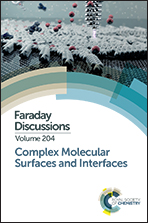Elucidating “screw dislocation”-driven film formation of sodium thiosulphate with complex hierarchical molecular assembly†
Abstract
Sodium thiosulphate (Na2S2O3) films were synthesized on carbon steel substrates through solution deposition, and a film formation growth mechanism is delineated in detail herein. Dislocation-driven film formation took place at the lower concentration of Na2S2O3 (0.1 M) studied, where screw dislocation loops were identified. Interestingly, we observed the co-existence of screw dislocation spiral loops and hierarchically-ordered molecular assembly in the film, and showed the importance of hierarchical morphology in the origin of screw dislocation. The screw dislocation loops were, however, distorted at the higher studied concentration of Na2S2O3 (0.5 M), and no hierarchical structures were formed. The mechanisms of film formation are discussed in detail and provide new insights into our understanding regarding morphology of the hierarchical molecular assembly, screw dislocation loop formation, and the role of chemical elements for their development. The main crystalline and amorphous phases in the surface films were identified as pyrite/mackinawite and magnetite. As sodium thiosulphate is widely used for energy, corrosion inhibition, nanoparticle synthesis and catalysis applications, the knowledge generated in this study is applicable to the fields of corrosion, materials science, materials chemistry and metallurgy.
- This article is part of the themed collection: Complex Molecular Surfaces and Interfaces


 Please wait while we load your content...
Please wait while we load your content...